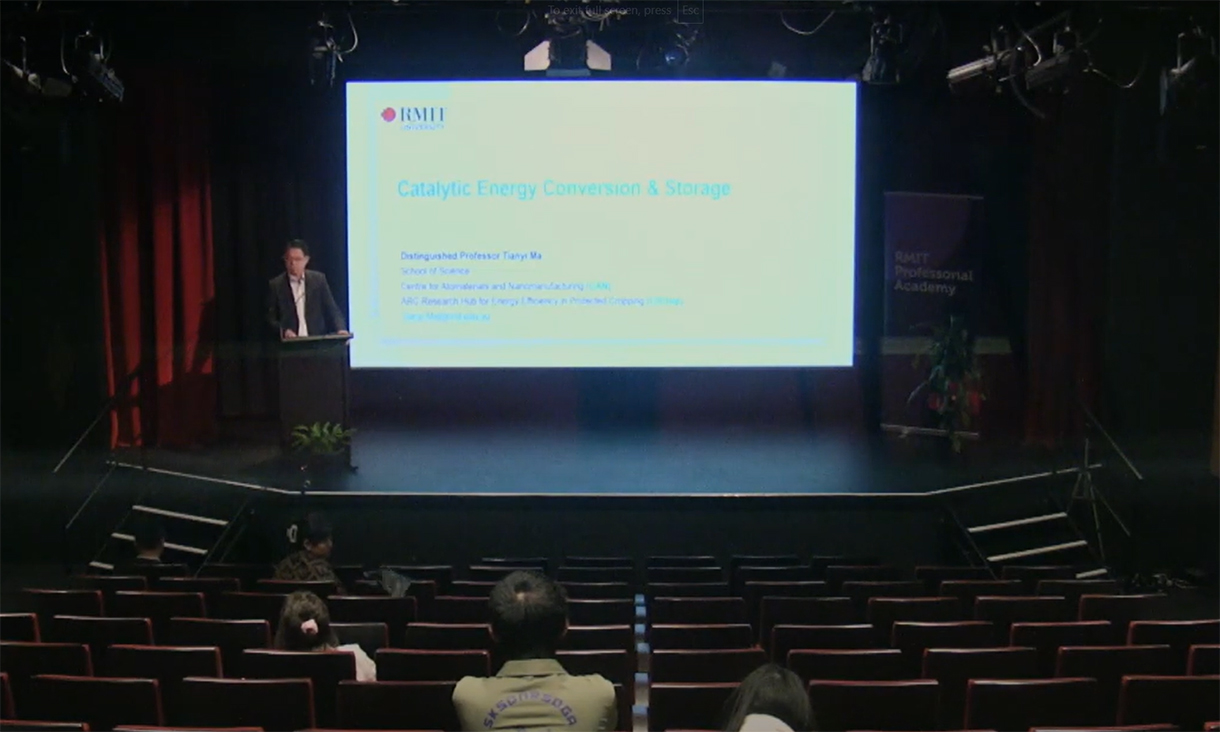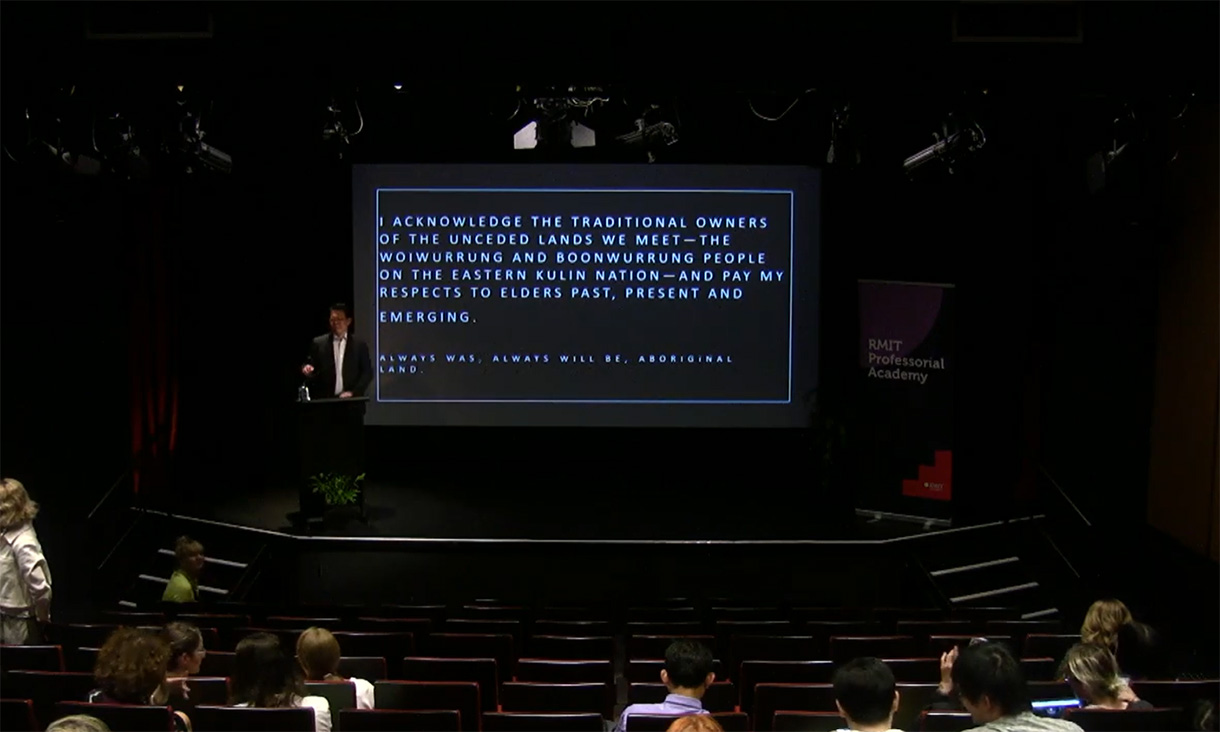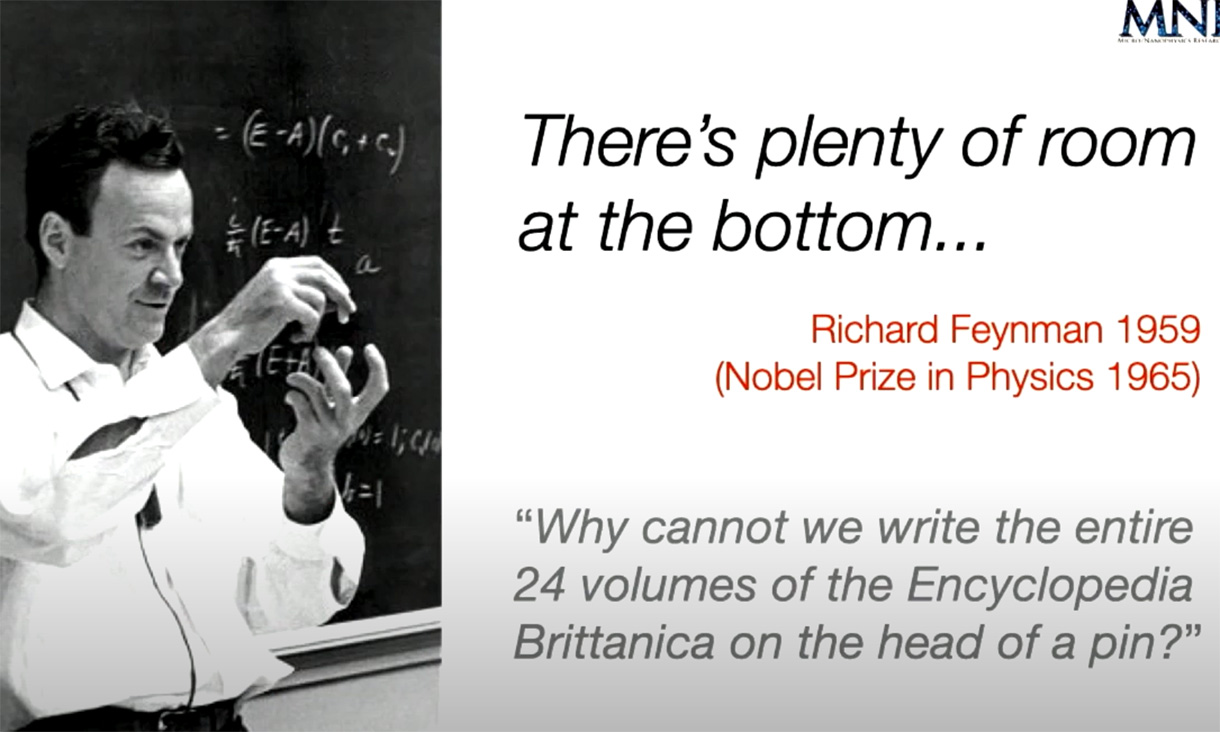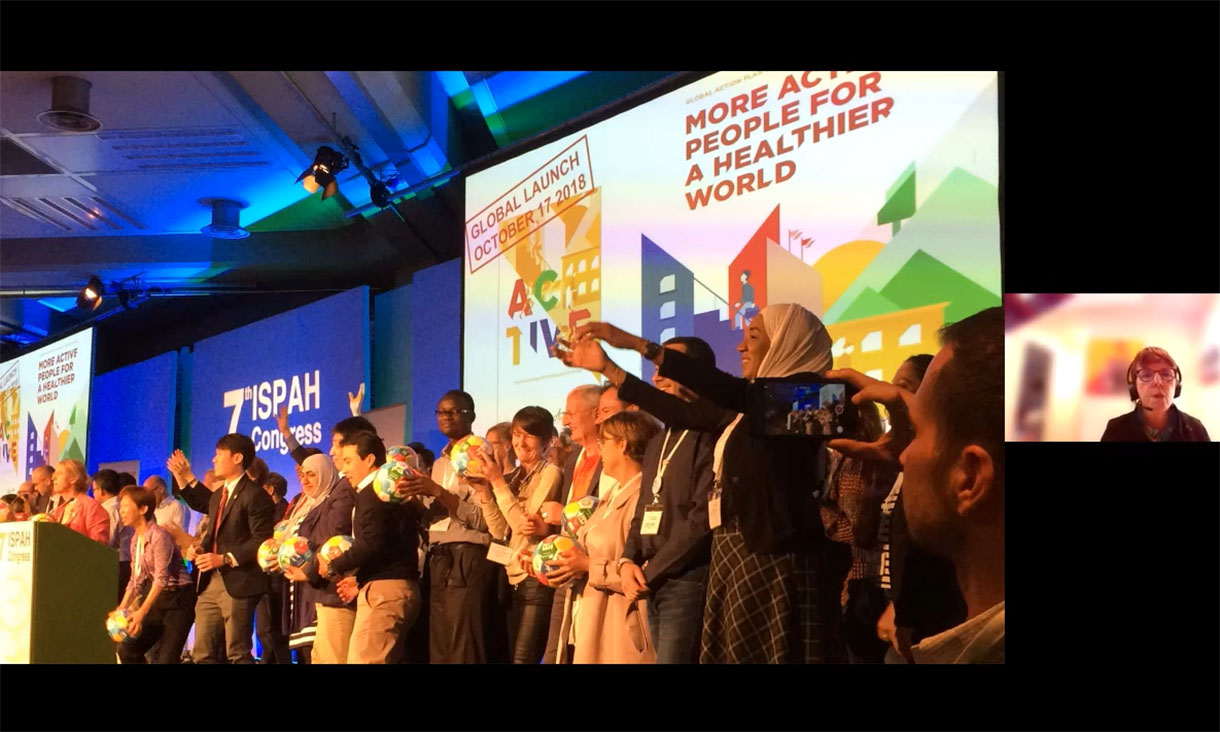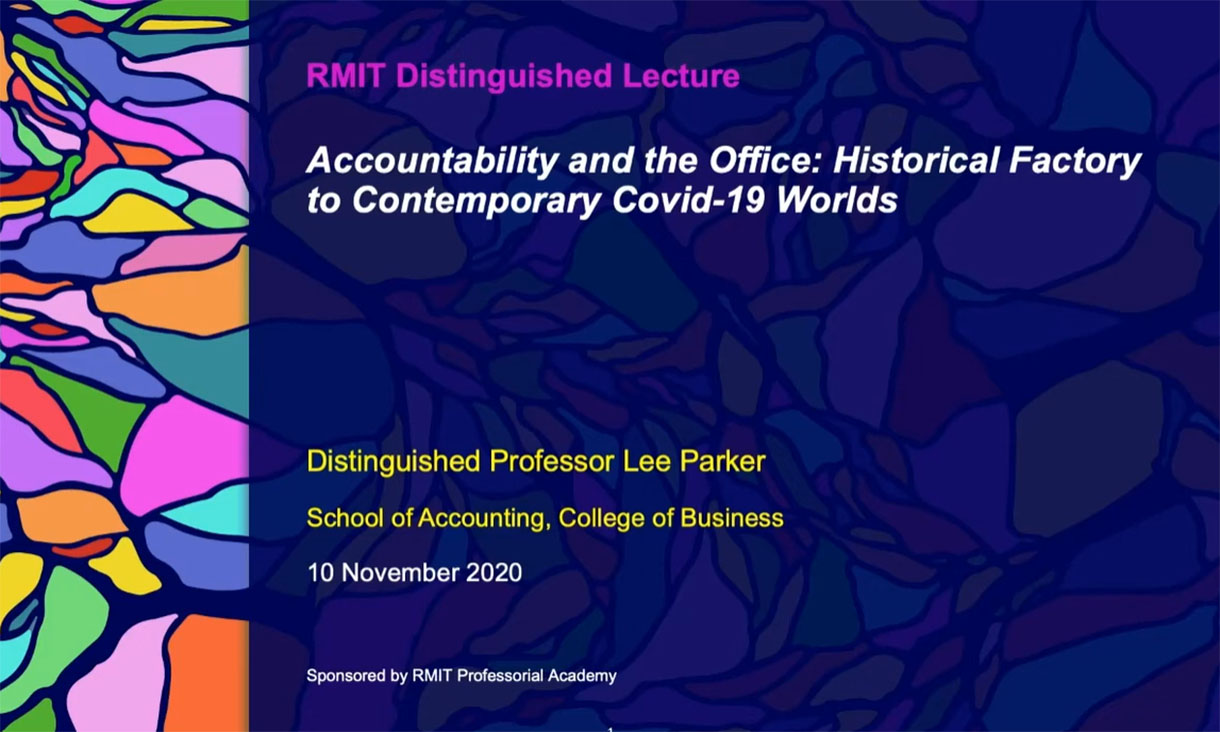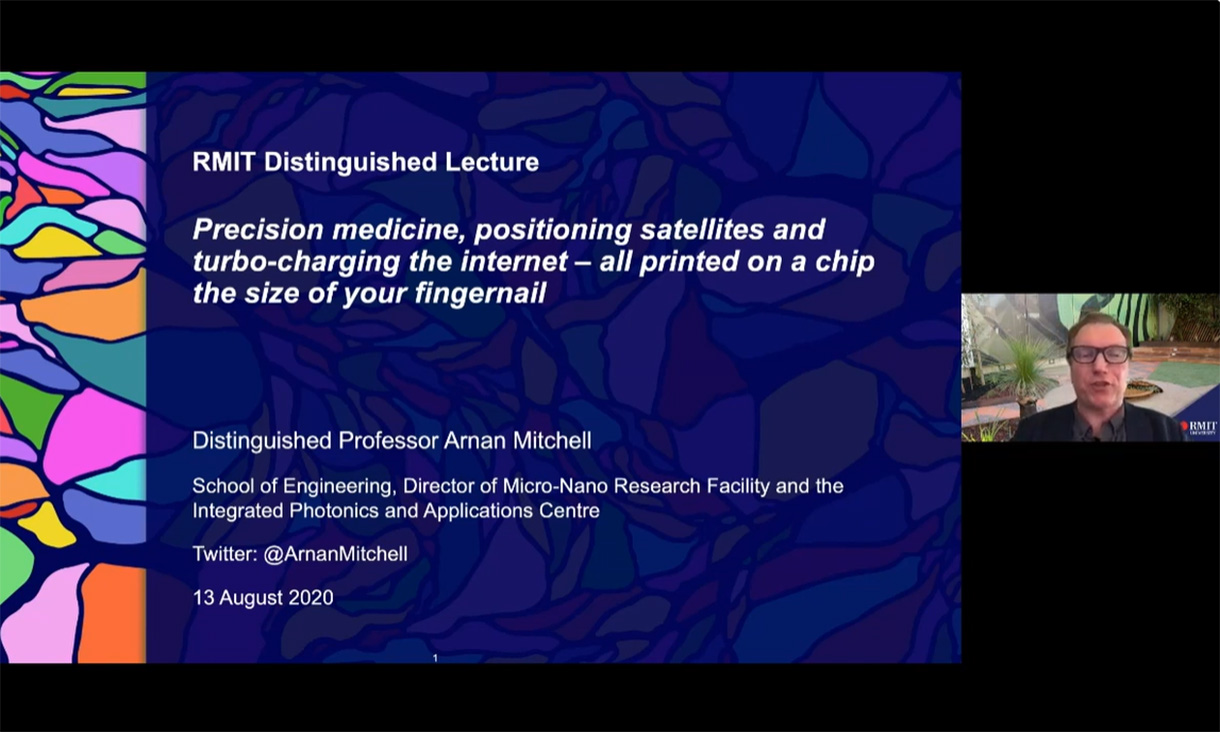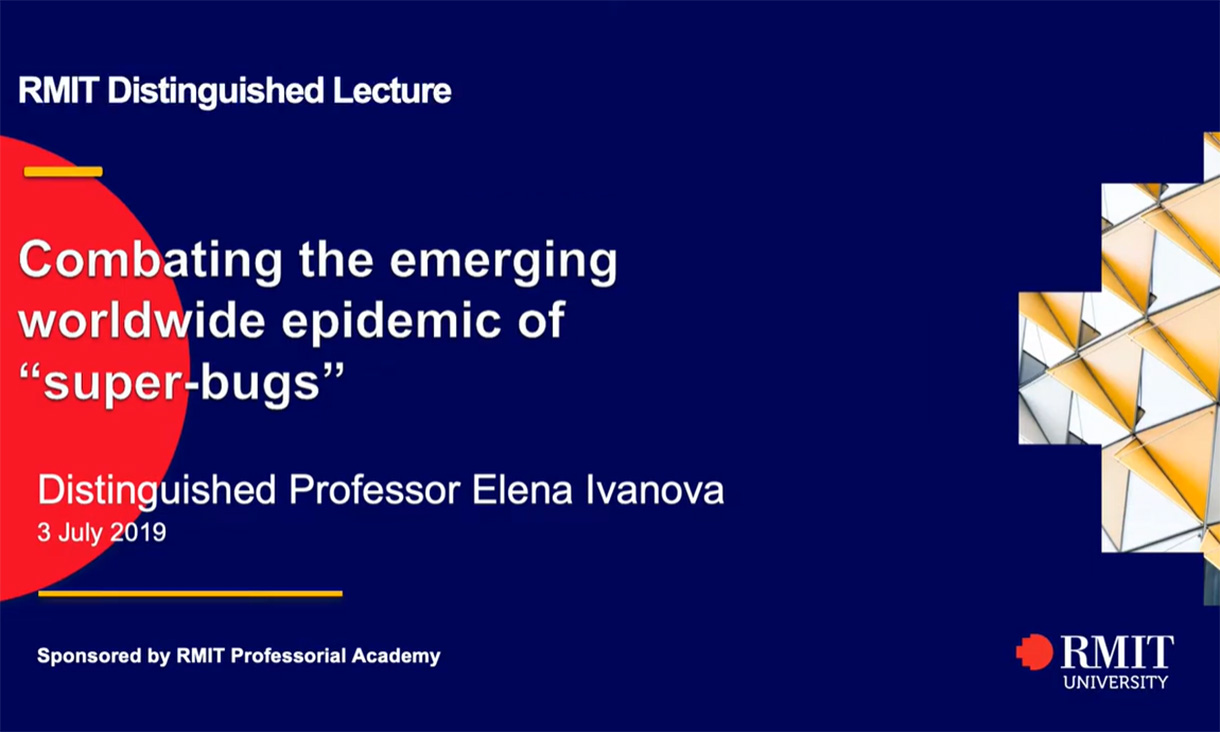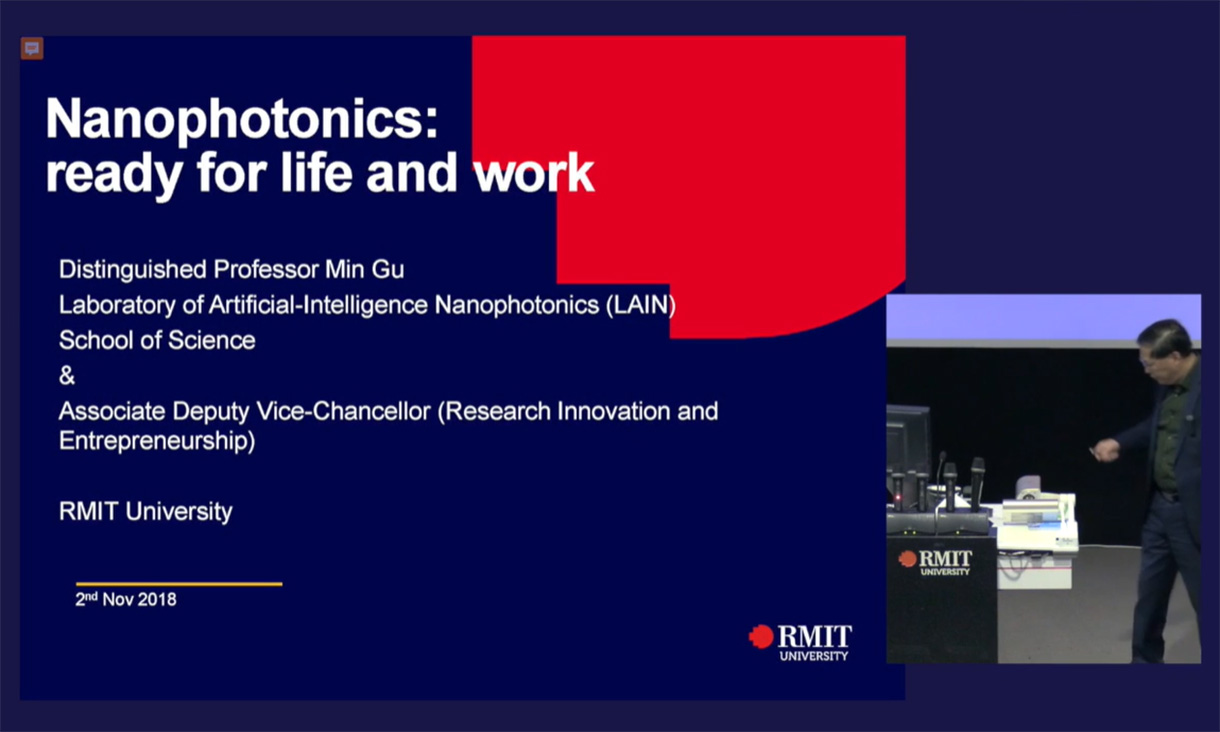The RMIT Professorial Academy serve as ambassadors, advising on issues of importance to RMIT and the community, driving thought leadership and impact.
About the academy
The RMIT Professorial Academy was established in 2018 to bring together RMIT’s best minds in research, education and engagement to:
- Serve as a source of advice on issues of importance to RMIT’s future and the communities we serve;
- Stimulate strategic conversations across RMIT and externally through Fellows acting as Thought Leaders; and
- Advocate and campaign for value creation and impact as Ambassadors.
The Academicians are known as Fellows of the RMIT Professorial Academy.
The Fellows have been appointed through recognition of their sustained outstanding performance and awarded with the Distinguished Professorship title before being inducted into the Academy.
 Pictured left to right: Distinguished Professor Elena Ivanova, Distinguished Professor Anthony Forsyth, Distinguished Professor Rachel Caruso, Distinguished Professor Milan Brandt, Distinguished Professor Barbora de Courten, Distinguished Professor Xinghuo Yu (Chair), Distinguished Professor Magdalena Plebanski, Distinguished Professor Irene Yarovsky, Distinguished Professor Julian Thomas, Distinguished Professor Baohua Jia, Distinguished Professor Andy Ball, Distinguished Professor Suresh Bhargava, Distinguished Professor Jie Yang, Distinguished Professor Mike Xie and Distinguished Professor Tianyi Ma. Absent: Distinguished Professor Larissa Hjorth, Distinguished Professor Helen Lingard, Distinguished Professor Arnan Mitchell, Distinguished Professor Jason Potts, Distinguished Professor Ma Qian, Distinguished Professor Cuie Wen, Distinguished Professor Charlie Xue, and Distinguished Professor Leslie Yeo.
Pictured left to right: Distinguished Professor Elena Ivanova, Distinguished Professor Anthony Forsyth, Distinguished Professor Rachel Caruso, Distinguished Professor Milan Brandt, Distinguished Professor Barbora de Courten, Distinguished Professor Xinghuo Yu (Chair), Distinguished Professor Magdalena Plebanski, Distinguished Professor Irene Yarovsky, Distinguished Professor Julian Thomas, Distinguished Professor Baohua Jia, Distinguished Professor Andy Ball, Distinguished Professor Suresh Bhargava, Distinguished Professor Jie Yang, Distinguished Professor Mike Xie and Distinguished Professor Tianyi Ma. Absent: Distinguished Professor Larissa Hjorth, Distinguished Professor Helen Lingard, Distinguished Professor Arnan Mitchell, Distinguished Professor Jason Potts, Distinguished Professor Ma Qian, Distinguished Professor Cuie Wen, Distinguished Professor Charlie Xue, and Distinguished Professor Leslie Yeo.
Distinguished Lectures
The RMIT Distinguished Lecture Series is sponsored by RMIT Professorial Academy (the RMIT Academy), which aims to:
- Promote excellence in research and innovation, learning and teaching, and engagement; and
- Engage with industry, community, business, government and the public through leading open strategic discussions on key issues of relevance to the local, Australian and global communities.
Tues 29 April 2025, presented by Distinguished Professor Tianyi Ma
As the world transitions to renewable energy, we must improve every part of the clean energy supply chain to achieve net-zero emissions. Traditional methods of producing hydrogen, capturing carbon, and storing energy face challenges such as high costs, inefficiency, and environmental impact. To solve these issues, new technologies are emerging—such as solar-powered hydrogen production, advanced carbon capture and conversion, and next-generation batteries that store energy more efficiently. These innovations make clean energy more reliable, affordable, and scalable, helping industries and communities move away from fossil fuels. By continuously improving these technologies, we are building a future where renewable energy can power our world sustainably, reducing emissions and combating climate change on a global scale.
28 November 2024
The RMIT Professorial Academy hosted a thought-provoking forum that brought together academic leaders and experts in RMIT to examine the transformative potential of Generative AI in a dual-sector university environment, along with its associated challenges and opportunities. The forum commenced with a keynote address by Professor Lisa Given, "Socially Responsible AI Practices: Moving from Hype to Hope in Higher Education." The keynote was succeeded by an engaging panel discussion featuring:
- Professor Lisa Given – Director, Social Change Enabling Impact Platform (EIP)
- Professor Matt Duckham – Director, Information in Society EIP
- Dr Hilary Wheaton – Principal Advisor, Educational Practice Learning and Teaching
- Professor Falk Scholer – Director, Centre for Human-AI Information Environments
- Distinguished Professor Xinghuo Yu (Moderator) – Chair, RMIT Professorial Academy
11 November 2024, presented by Distinguished Professor Larissa Hjorth
From Instagram eulogies of human and more-than-human kin to witnessing mass human destruction on TikTok—mobile media practices play a significant role in contemporary grieving, memorializing, and mourning rituals in an age of permacrisis (permanent crisis). From the climate emergency feelings of ecogrief and the devastation of witnessing war and death to the individual loss of our human and more-than-human loved ones, our mobile devices bear witness to the intimate, affective, embodied and collective ways we mourn in, and through, contemporary media. While all witnessing is effective, I suggest that the embodied and intimate dimensions of mobile media create and curate different possibilities and relationalities. In this talk, I draw on my Australian Research Council Future Fellowship, which seeks to understand the role of mobile media mourning rituals as a reflection of our social, cultural, and emotional lives.
15 October 2024, presented by Distinguished Professor Baohua Jia
"Atomaterials" represents materials with at least one dimension on the atomic scale. Their properties depend on the precise configuration of their atoms. It is a new but rapidly developing field. A typical atomaterials is graphene, which is made of carbon atoms. Unlike diamond, in which the carbon atoms form a rigid three-dimensional structure, graphene is made of a single layer of carbon atoms bonded together in a two-dimensional honeycomb lattice. They show exceptional properties due to their atomaterials nature. Using atomaterials, our lab has been working on a range of innovations at various stages of development, for example, a diurnal cooling film without consuming electricity. This film can cool the environment by up to 15°C without electricity. Integrating such a film into a building can dramatically reduce the electricity used for air conditioning. This will not only save electricity bills but also reduce greenhouse emissions. Heat-absorbing film, achieving over 97% energy conversion rate with an ultrathin film arrangement. These materials play a critical role in improving energy efficiency and providing innovative, sustainable solutions for our society.
5 August 2024, presented by Distinguished Professor Jason Potts
We are today in the early phases of a profound transition to a digital economy. In this lecture I will set out a new theory of where it came from, what it is, and why it matters. My argument is that a digital economy does not mean computers everywhere, but is the transition to digital institutions. A digital economy is a new type of economy – fundamentally different from an industrial economy – owing to the way in which these institutions (e.g. digital money and assets, digital markets, contracts and platforms) are composable to coordinate economic actions and compute value. In a digital economy 'the commons' is a far more powerful institution than in an industrial economy. This gives rise to new types of capital (as forms of 'hyperobjects'), new ways of organising production (in what we call 'contribution systems'), and new sources of property rights (as 'tokens'). The cheap new resource in a digital economy is not data per se, but rather the ability to spin-up a full stack economy from within civil society. This new institutional capability is the most disruptive factor of our time. Furthermore, alongside the technological, material and moral progress that the industrial era advanced, this leads to the prospect of institutional progress and the beginning of the end of politics.
29 March 2024
ChatGPT has become a global sensation since its release in November 2022 by OpenAI, which can answer questions, draft essays, summarise documents and create software in a heartbeat. RMIT Professorial Academy and RMIT Research Committee hosted a panel discussion that looked into basics of ChatGPT and underpinning AI technologies, uncover its myth, assess its implications and challenges, and explore its opportunities for the future, in particular, in research and innovation, teaching and learning, management and services, and beyond.
Panel members:
- Professor Lisa Given – Director, Social Change Enabling Impact Platform
- Nonna Milmeister – RMIT Chief Data and Analytics Officer
- Professor Karin Verspoor – Dean School of Computing Technologies
- Dr Hilary Wheaton – Principal Advisor, Educational Practice Learning and Teaching
- Professor Falk Scholer – Director, Centre for Human-AI Information Environments
- Distinguished Professor Xinghuo Yu (Moderator) – Chair, RMIT Professorial Academy
8 Nov 2023, presented by Distinguished Professor Leslie Yeo.
The ability to translate conventional laboratory operations, such as sample preparation and handling, reaction, separation (e.g., centrifugation) and analysis, onto low-cost portable handheld platforms offer tremendous opportunities for many applications across healthcare and environmental monitoring. Yet, miniaturising seemingly simple processes in the laboratory onto chipscale devices is not a trivial exercise, owing to the vastly different physics that dominate at small scales. In this talk, we show how a unique form of sound waves that resemble nanoscale earthquakes can be utilised to facilitate such miniaturisation, and hence the development of practical technology for medical diagnostics and therapeutics at the point-of-care, or environmental monitoring in the field.
31 October 2023, moderated by Distinguished Professor Anthony Forsyth.
The Albanese Government's Fair Work Legislation Amendment (Closing Loopholes) Bill was introduced into Parliament on 4 September 2023. The Bill proposes major reforms to the regulation of platform work in Australia, including powers for the Fair Work Commission to set standards and settle disputes for employee-like workers. These are world-leading reforms which address mounting evidence that work for many in the gig economy has become unfair and unsafe. In this RMIT Distinguished Lecture Series panel discussion, our speakers will provide union, industry and policy perspectives on the likely impact of these significant reforms in the food delivery, rideshare and care sectors in particular.
The discussion will be moderated by RMIT Distinguished Professor Anthony Forsyth, whose 2022 book The Future of Unions and Worker Representation: The Digital Picket Line devotes several chapters to gig work and policy/reform proposals. Discussants:
- Michael Kaine, National Secretary, Transport Workers Union of Australia
- Dr Fiona Macdonald, Policy Director, Industrial and Social, Centre for Future Work (Australia Institute)
- Neil Pharaoh, Director of Corporate Affairs for Hireup, a leading National Disability Insurance Scheme registered online platform which employs all its workers
Tues 26 Sept 2023, presented by Distinguished Professor Irene Yarovsky.
The role of computers in our everyday life is ever increasing, from basic arithmetic to complex data analysis and major contributions to physical sciences, engineering, medicine, and business processes. We employ high performance computing to theoretically model interactions between individual atoms in natural and man-made materials to facilitate and accelerate the design and engineering of new and improved materials for optimal performance, controlled environmental responses, robustness, and safe exploitation in industrial and biomedical settings. This talk presents a historical perspective and examples of our molecular models that empowered advanced materials design in collaboration with RMIT's industry and academic research partners through an in-depth understanding of fundamental intermolecular interactions in realistic environments.
21 June 2023, presented by Distinguished Professor Magdalena Plebanski
Given the immune system changes with age, increased longevity often brings increased susceptibility to infections and cancer. Males and females further often show different immune system profiles in response to vaccines.
To optimise the application of vaccines and therapies across the lifespan, we need to both understand how current vaccines work in different individuals against diseases such as COVID19 or Flu in human clinical trials, as well as defining how fundamental features of vaccine components such as nanoparticles (size, shape or protein corona), affect their interactions with the immune system. Such studies include using big data tools for studying new beneficial non-specific effects (NSEs) of vaccines.
We further have a specific interest in helping women with ovarian cancer, the most lethal gynaecological malignancy, across the spectrum of needs, from earlier diagnosis to more effective treatments, as well as the long-term aim of developing cancer vaccines, collaborating broadly across disciplines.
Mon 7 Nov 2022, presented by Distinguished Professor Ma Qian
Nature is the greatest metallurgist. All metals we know or use today were part of the stars in the universe at one time or another: fabricated by nature, for example through the merger of neutron stars. Metallurgy has continued to evolve from the ancient art of extracting metals from ores to materials science and engineering, which now includes the study of the physical, chemical, and aesthetic properties of metallic materials at different length scales, as well as the design and manufacture of novel metallic materials.
Today, metallurgists continue to learn the art and science of metallurgy and fabrication from nature, down to the atomic level compared to the original mythical connection, thanks to our enhanced understanding of nature.
This lecture explores the connection between modern metallurgy and nature through a series of examples, incl. Voronoi patterns, macroscopic igneous rocks, microscopic columnar crystals in 3D-printed metallic materials, and the dual role of substrate materials in ice nucleation in nature and metal solidification.
Wed 10 Aug 2022, presented by Distinguished Professor Billie Giles-Corti
This talk will describe the journey and present the results for our key questions: Do we have the city planning policies in place to deliver healthy and sustainable cities worldwide? And are there inequities in access to health-supportive environments within and between cities? Our work was recently published in The Lancet Global Health series on Urban Design, Transport and Health.
17 May 2022, presented by Distinguished Professor Arnan Mitchell
From accurately tracking and estimating our Google Maps journeys to using biomedical imaging to gain detailed images inside our bodies, being able to measure things precisely underpins almost everything we do.
In 2005, two physicists were awarded the Nobel Prize for developing an approach – the optical frequency comb – to measure almost anything with unprecedented precision. This approach gave us the GPS we use on a day-to-day basis, however, it was also expected to change the way we measure many other things, from the gases in our atmosphere to the discovery of earth-like planets in distant solar systems.
Seventeen years on, the world-changing potential of optical frequency combs remains largely untapped, mainly due to their large size and complexity. Photonic chip technology – technology that can miniaturise entire lab benches onto a chip the size of a fingernail – may hold the answer. Distinguished Professor Arnan Mitchell discusses how photonic chip optical frequency combs could lead to 3D analysis of living organisms, map and monitor the geological structure of our lands and oceans, and allow brain-like machine learning to transform the behaviour of autonomous drones and satellites.
30 November 2021, presented by Distinguished Professor Sara Charlesworth
The crisis faced across the OECD in the provision of aged care was made visible to the broader community during the COVID-19 pandemic. In making the link between the quality of care and the working conditions of the frontline workers who provide the care, the lecture draws on a body of collaborative research conducted over the last decade.
Funded by the Australian Research Council and the Canadian Social Sciences & Humanities Research Council these different projects provide multi-level insights into the ways in which the interaction of gendered care, employment and migration regimes can produce both unacceptable care and unacceptable forms of work.
These research findings also point to the systemic changes required to ensure that frontline workers have the economic security and time to enable diverse cohorts of older adults to age with dignity.
26 October 2021, presented by Distinguished Professor Magdalena Plebanski
Ovarian cancer is the fifth leading cause of death for women globally. Early diagnosis is key to improve survival, but there are currently no reliable screening biomarkers for early stage disease. Moreover, after initial clinical responses to first-line treatment, in most women the cancer comes back, often resistant to the first-line drug platinum.
We have found new diagnostic biomarkers, and collaborate with nano-engineers to develop innovative devices so women can in the future be easily and reliably screened at GP clinics or at home. We further work with clinicians and chemists developing new drugs and immuno-therapies to treat platinum resistant cancers.
Since most patients are older women, we further investigate the unique characteristics of the immune system of older individuals. These fundamental big data 'omics' bioinformatics studies are also providing new insights on how to optimise vaccines to protect older adults, for example against influenza and COVID19, as well as cancer itself.
8 September 2021, presented by Distinguished Professor Julian Thomas
From café culture to home schooling, remote community networks, and smart cities, Wi-Fi is an invisible but fundamental element of contemporary life. Loosely regulated, low-cost, and largely overlooked by social researchers, this technology has driven the rise of the smartphone and broadband internet, and is now a vital element in the next wave of automation. During the pandemic, household Wi-Fi has been critically important for connected households, enabling new ways of working from home and maintaining social links.
At the same time, the closure of libraries, campuses and other public Wi-Fi locations has exacerbated disadvantage for people without ready access to the internet. This talk reviews the history of wi-fi, showing how a technology originally designed to connect cash registers came to play an important social role. It describes Wi-Fi’s immediate prospects, including its relations to high speed 5G cellular services, and its possible longer-run social futures, which may hinge upon its uniquely decentralised and inclusive capabilities for automation.
25 May 2021, presented by Distinguished Professor Andy Ball
The ARC Training Centre for the Transformation of Australia’s Biosolids Resource, based at RMIT’s West Bundoora Campus, brings together Australia’s leading biosolids researchers and key industry and government stakeholders to advance the management, transformation and reuse of biosolids in agriculture.
The Centre's focus is 1) capability and knowledge building, 2) research development, extension and training, and 3) sustainable strategic partnerships.
The expected outcomes of the Centre are to develop a group of new, highly-trained industry-ready researchers, and advanced solutions in three major themes: improved technologies, enhanced products, and sustainability. This will provide significant benefits in the economic value of new applications and market opportunities as well as deliver cost-savings – all in an environmentally friendly manner. This presentation will examine the rationale and expectations of the 5-year research and training program.
21 March 2021, presented by Distinguished Professor Helen Lingard
Construction accounts for 9% of the national workforce but 12% of work-related fatalities. Every year some 12,600 compensation claims are accepted from construction workers for injuries and diseases involving lengthy workplace absences. SafeWork Australia identifies supply networks as a national action area for work health and safety (WHS) improvement and construction as a priority industry. The complex nature of the construction industry’s supply network requires WHS risks to be identified and managed across multiple organisational boundaries and interfaces. In this lecture, RMIT Distinguished Professor Helen Lingard will present findings from an ongoing program of research examining organisational, structural and cultural challenges inherent in managing WHS in complex construction supply networks. The lecture will consider how best to integrate WHS into construction planning and design and present lessons relating to clients’ use of commercial mechanisms to embed WHS requirements in the commercial frameworks used to deliver projects.
10 November 2020, presented by Distinguished Professor Lee Parker
From the emergence of the Industrial Revolution factory to today's multi-storey office building, the office has permeated organisational, economic and social activity for over 200 years. For profit, non-profit and public sector organisations, it has become a major site of clerical and professional labour, and a centre of strategic management, management control, service delivery and accountability discharge. Its location, configuration, functions and processes vitally impact organisational activity and outcomes. This presentation reveals the historical and persistent influence of scientific management on the office and its role as a site of internal and external surveillance, control and governance. Behind frontstage facades of innovative design, backstage agendas of cost efficiencies and client impression management will be unveiled. In today's covid-19 environment, the implications for occupational health and safety of corporate investments in open plan, hot desk and Activity Based Working designs and the pressures for their re-engineering and relocation, will be evaluated.
29 September 2020, presented by Distinguished Professor Xinghuo Yu
Cyber-Physical Systems (CPS) represent a broad range of complex, physically aware engineered systems which integrate information and communication technologies (ICT) into physical systems for efficient and effective automation and control. A typical example is a smart grid which allows affordable and secure power supply and use while helping reduce carbon footprints. Recent fast ICT advances have made situation awareness possible for better management and operation of CPS. This has also led to explosive growth of spatio-temporal information and complexity. An innovative way of thinking and doing is needed to tackle these large-scale complex problems efficiently and effectively.
In this talk, we will first review recent developments in CPS and their challenges. We will then advocate for a novel problem-solving paradigm, the so-called simplexity approach underpinned by a 'simple solutions for complex problems' philosophy, to deal with large-scale complex CPS. Several nature-inspired methodologies such as AI, swarm intelligence and complex networks will be examined for modelling, control and optimisation of CPS. Some real-world problems, such as money laundering network detection and autonomous microgrid network for power supply from our own research projects, will be used as case studies.
3 September 2020, Presented by Distinguished Professor Arnan Mitchell
My team works with technologies that have the potential to help every Australian stay healthier, safer, and more connected than ever. They are developing systems to diagnose and treat diseases, they’re turbo-charging the internet with ultrafast fibre optics and they are creating technologies for precise positioning of everything from self-driving cars to satellites.
How are we doing it? We’re using integrated photonics - the successor to microelectronics - where both electricity and laser light can be captured and controlled on a chip the size of your fingernail, all at a price of only a few dollars.
This technology is surprisingly adaptable and yet scalable to mass manufacture. In this lecture I will show how this technology is also accessible to even quite small companies, right here in Australia and I will share my vision of building a technology manufacturing base to advance our position as global leaders not just in science and technology but also industrial commercialisation.
3 October 2019, Presented by Distinguished Professor Suresh Bhargava
* due to technical limitations, we are unable to provide a transcript of this presentation. If you are experiencing difficulties viewing this video please contact Distinguished Professor Suresh Bhargava for more information.
Building upon his know-how on the development of gold-based materials, Prof. Bhargava has developed gold-based molecules and nanoparticles for cancer treatment and mercury sensing, respectively, combining research excellence with research relevance.
Prof. Bhargava’s research introduces a highly promising family of gold-based drugs which are found to be highly cytotoxic against various cancer cell lines with high selectivity. This patented family of gold-based drugs can provide a safe treatment to cancer patients with minimal side effects compared to current medicines.
Using gold at the nano level, Prof. Bhargava has created advanced materials for mercury detection and abatement technology. This patented technology is capable of measuring toxic mercury levels in harsh industrial processes and effluent streams
3 July 2019, Presented by Distinguished Professor Elena Ivanova
The threat of a global rise of untreatable infections caused by antibiotic-resistant bacteria calls for the design and fabrication of a new generation of biomaterials. Following the discovery of the efficient, bacteria-killing nature of insect wing surfaces, the properties of these biological nanostructures have recently become the subject of intense investigation, promising to play a large role in combating the emerging, worldwide epidemic of "super-bugs."
The formation of bacterial biofilms has been prevented for many years through adapting the physical and chemical properties of a variety of medical tools, particularly the surfaces of instruments and implants. Recent studies of insect wings have shown that they are covered with nano-pillared arrays lethal to most species of pathogenic bacteria. Rather than relying on a combination of physical and chemical properties to combat biofilm formation, the mechanism of the antibacterial activity of nanostructured surfaces has been described in terms of purely physical, "mechano-bactericidal" effects. So far, several synthetic bactericidal surfaces, e.g., "black silicon," was synthesised as an analogue of an insect wing's protective surface and was reported to induce a biocidal effect, physically "bursting" the small, Gram-negative and Gram positive bacteria while leaving the host's large eukaryotic cells intact; however, the precise role of this and other nano-architectures in fighting pathogenic bacteria remains a complex mystery to be solved.
As a pioneer in biomimetic antibacterial surfaces, Distinguished Professor Elena Ivanova has developed an innovative concept of eco-friendly bactericidal nanostructured materials, which are capable of physical killing of all types of bacterial cells including “super-bugs”.
13 March 2019, Presented by Distinguished Professor Mike Xie
Distinguished Professor Mike Xie and his team have developed an innovative design methodology to remove under-utilised material from structures, producing highly efficient and strikingly elegant designs. This technique can significantly reduce the weight and the associated energy consumption of aircraft and motor vehicles. In this lecture, Mike will show a wide range of practical applications of his bi-directional evolutionary structural optimisation (BESO) method, including spectacular buildings and bridges, unmanned aircraft, mechanical metamaterials and structural connections. Mike will also demonstrate how such organic designs can be effectively realised using advanced manufacturing technologies including 3D printing. The new design methodology and advanced manufacturing technologies will change the way we design and construct our future built environment.
4 December 2018, Presented by Distinguished Professor Billie Giles-Corti
In the 21st century, cities are facing massive health challenges globally: population growth, rapid urbanisation, traffic congestion, poor air quality, noise and climate change combined with increases in physical inactivity, unhealthy diets, non-communicable diseases (NCDs), road trauma, and obesity. Optimising city planning to promote physical and mental health and community wellbeing, in the face of rapidly growing urban populations is critical. Integrated regional urban and transport planning and local urban design strategies are needed to achieve cities that promote health and wellbeing, and to achieve the UN’s Sustainable Development Goals. While local conditions will determine the mix of interventions, our overall goal must be to create safe, liveable, convivial and healthy cities that promote active and more sustainable lifestyles that reduce non-communicable diseases and other adverse health risks. This requires integrated metropolitan and regional urban and transport planning incorporating pedestrian- and cycling-friendly local urban design. There is an urgent need for policy-relevant research to be undertaken in partnership with policy-makers; as well as advocacy to ensure that the rhetoric of ‘healthy liveable, sustainable’ cities translates into well designed cities that can confront these major 21st century challenges. This is a big agenda that requires interdisciplinary research and genuine partnerships between researchers and policy-makers. The question is are we up for it? And if so, what needs to be done and how? This talk will consider these questions by drawing of recent policy-relevant research conceptualising and measuring ‘urban liveability’. Through the lens of the Urban Futures Enabling Impact Platform, it will consider not only the role of academics, but also the role of policy-makers in achieving the vision of a healthy, liveable and more sustainable future.
2 November 2018, Presented by Distinguished Professor Min Gu
Nanotechnology has transformed massively our everyday life and global economy for a sustainable future. Nanophotonics, which studies optical science and technology at a nanoscale, has enabled the development of optical and photonic devices that provide a green-technology platform. In this talk, I will show the development of ultra-high capacity optical data storage technology which provides greener, longer and faster solutions to the era of big data. I will also show an entirely new the development of three-dimensional optical display, which is a vital platform for flexible mobile devices. I will then present fractal supercapacitors inspired by natural fern leaves, which removes the bottleneck barrier toward the daily applications of the technology. Driven by these achievements, the newly established nanophotonics laboratory at RMIT has embarked on a new journey to next-generation artificial intelligence with the speed of light.
Contact the Academy
Academy Chair
Distinguished Professor Xinghuo Yu
Phone: +61 3 9925 5317
Email: xinghuo.yu@rmit.edu.au
